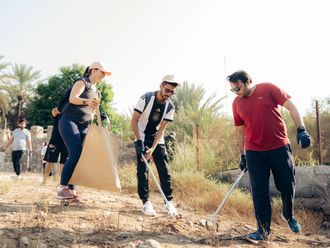Dr Essa Kazim |
The successful surgical separation and reconstruction of the Siamese twins Rashid and Hamdan from Iraq is a landmark in UAE medical history. The operation was carried out on November 24 at Dubai Hospital, a facility run by the Department of Health and Medical Services (DOHMS).
The twins were flown to Dubai and the entire expense of the surgery was borne by General Sheikh Mohammed bin Rashid Al Maktoum, Crown Prince of Dubai and UAE Minister of Defence.
Dr Essa Kazim, Assistant Hospital Director (Medical Affairs) and Head of the Department of Urology, spoke to Gulf News about the pioneering 14-hour medical procedure to disjoin the boys.
He said: "The twins were connected at the pelvis, end-to-end, with four normally moving lower limbs. Each baby had two hernias, they shared a urinary bladder, half of which could be seen externally. The genitalia was also involved. The mixing of organs is always seen in Siamese twins.
"As a result of this mixing, the abnormalities vary between every set of twins. So each case is unique.
"Luckily, the babies had no bone connection, which made for better prognosis. Although, the bones in the pelvic region were widely separated and there was a large gap to close. The legs were splayed and the hip joints had to be properly aligned.
"The kidneys were normal, along with some important parts of the reproductive system. They had other abnormalities which did not require any corrective surgery. One of the twins has his heart on the right as opposed to the left. His liver is also on the opposite side... to the left. However, both the organs are functioning normally.
"One of the twins also has a problem with the spinal column, the fifth thoracic vertebra is incomplete, leading to a slight bend in the column.
"The subject of rectifying surgery will have to be looked into and analysed around nine months later. The second twin has the same problem, but it isn't pronounced, so his spinal column is straight."
Dr Kazim said when the babies were flown in on October 11, they were undernourished. They were put into immediate medical care and investigations began.
Twins originate from a single fertilised egg that splits into identical halves or two separate eggs get fertilised giving rise to fraternal twins. In case of identical twins they are of the same sex.
The developing embryo starts to split into identical twins within the first two weeks after conception.
However, in Siamese twins, the process stops before it is complete. It leaves a partially separated egg which develops into conjoined twins. If they have separate sets of organs, chances for surgery and survival are greater than if they share the same organs.
Over the years, survival rates have improved as a result of more accurate imaging studies, along with better anaesthetic and operative techniques.
"A chromosomal test was done on the twins to confirm their sex, as it wasn't evident on clinical examination. Following a number of investigations, we were able to determine the mixing of organs to some extent. However, there are unexpected abnormalities, like in this case we didn't know the boys shared a common colon.
"So the surgery was a continually developing and evolving process, with decisions taken at every juncture."
He said Dubai Department of Health and Medical Services have the facilities and medical expertise required for the surgery. After comprehensive evaluation it was agreed that they would be able to help the twins.
"We informed Sheikh Mohammed of the results of our extended evaluation," he added. It was decided a special team with previous experience of surgeries in conjoined twins would also be brought in for the operation.
"Seven doctors including two urologists, two general surgeons, an orthopaedic surgeon and anaesthetists were flown in from the Great Ormond Street Hospital for Children in London, UK.
"This team was chosen because they have operated on 20 sets of Siamese twins previously. This was their 21st case. Each member of the team was handpicked, depending on expertise."
He said the risks involved in the surgery were high, especially as the three-month-old babies were to be under anaesthesia for a prolonged period.
"We did an extensive check on their hearts and lungs, but sometimes they may not have the reserve, and this could lead to severe complications."
The day before the surgery the entire team, which also included five doctors from Dubai, did a trial run to ensure as smooth a flow of the procedure as possible. This was necessary as, following separation, one of the babies was to be moved to another theatre.
On Sunday morning, the twins were put under anaesthesia at 8.00am. "The entire team worked together dissecting, separating and reconstructing.
"The surgery involved various steps including the separation of the different halves of the urinary bladder with the ureters attached, which then had to be flipped back into place in each infant.
"The two intact small intestines were moved so that each baby had one. It was then connected to the large intestine, which was divided between the two.
"Part of the reproductive system, especially the urinary tube or urethra had to be constructed. Everything was done using tissue from the area of dissection. The separation has to be done very carefully so as not to harm the blood supply system, or destroy the organs."
Once the small and large intestines were joined, they had to bring one end through the perineum - area around the intended anal opening - with the maximum musculature. This would help in natural bowel control for the children. Dr Kazim said they may have to "undergo surgery for continence" when they're around six to eight years of age.
As far as the bones of the pelvic region were concerned, there was no connectivity. However, they had to be moulded around so as to be able to provide proper support for the children while walking.
"If this correction wasn't done, the children would waddle for the rest of their lives. A pin was placed through their hips to keep the bone in place, and this was removed later.
"The legs are in plaster of Paris cast and held together in a natural position with a bridge. In three weeks' time, the casts will be removed, as the part of the bone at the back, which has been cut to mould it around would have healed."
He said the reconstructions have been anatomically accurate and should function normally. The surgical procedure lasted until 10.30pm.
Dr Kazim said: "We have a normal life expectancy for these children with all their systems working fine. They're doing well now. The entire process was possible because everybody worked together as a team in the best manner possible in pre-operative, operative and post-operative care.
"This was the first successful surgery of its nature in the UAE and is a reflection of what we are capable of doing.
"DOHMS is continually growing and developing. There is always room for improvement. As Sheikh Mohammed said, 'there is no finish line in the race for excellence', our medical services can and will do better," he said, referring to the recently announced plan by Sheikh Mohammed to set up the $1.8 billion Dubai Healthcare City.
As part of Dubai's 2010 Strategic Vision, the project wi










